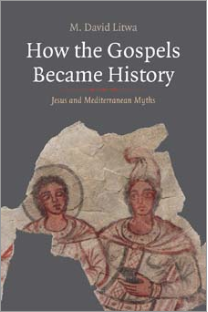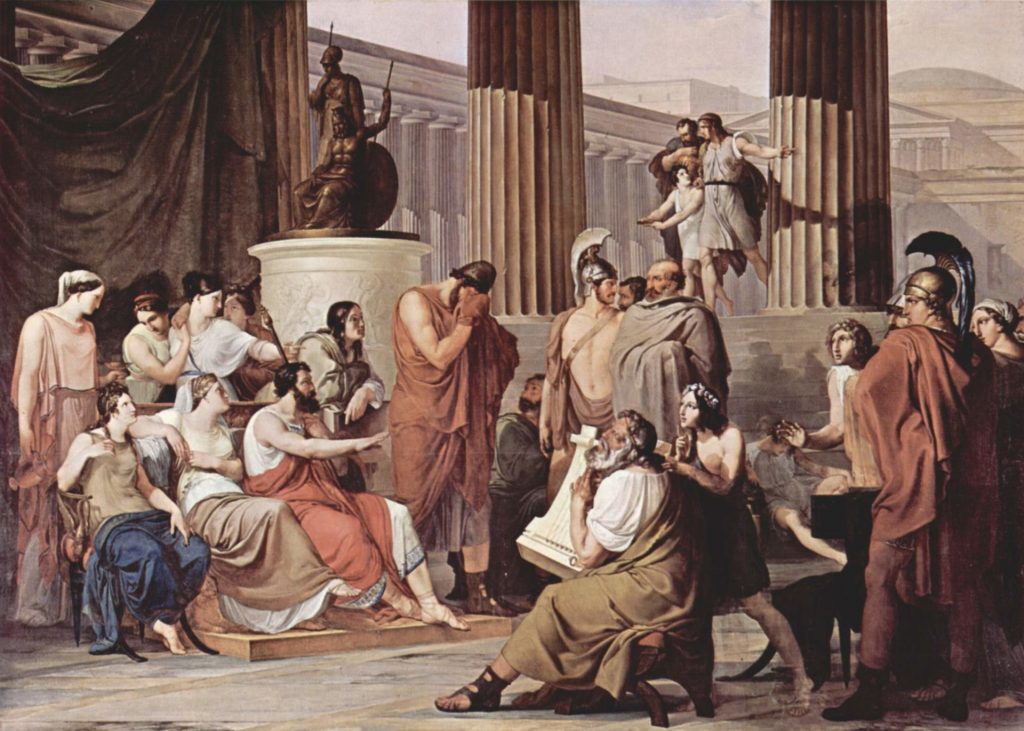 This is probably my favourite chapter in How the Gospels Became History by M. David Litwa. Is #15, “Eyewitnesses”.
This is probably my favourite chapter in How the Gospels Became History by M. David Litwa. Is #15, “Eyewitnesses”.
— Who Is the Beloved Disciple? — I like Litwa’s answer to that question better than any argument that it was Paul or Mary or John or . . . .
— And does not striking life-like vividness of detail in a narrative strongly indicate an eyewitness report? It’s refreshing to see a biblical scholar answer that question in the negative.
But first, some opening quotes to give you the main drift:
Through the eyes of the literary eyewitness, a subjective and spiritual event could be represented as real and verifiable. . . .
Fictive or not, eyewitnesses were greatly valued in ancient Mediterranean culture. . . .
(Litwa, 194)

Odysseus is weeping at the court of Alcinous as the blind minstrel Demodocus sings about Odysseus and Achilles at Troy while playing the harp. (Wikimedia)
Vivid detail?
Let Homer answer the question, so often asked rhetorically when apologists insist on the historicity of the gospels.
In Homer’s Odyssey, the hero Odysseus praises the singer Demodocus for relating the events of the Trojan War “as if you were present yourself, or heard it from one who was.” Demodocus was definitely not present, a point that Odysseus well knows. Still, by means of his vivid presentation, Demodocus could make it seem as if he were an eyewitness or had heard from one who was. Homer knew that if one was not an eyewitness, skillful literary art could produce an eyewitness effect.
(Litwa, 194 f)
Historians and eyewitness reports — comparing the gospels
Litwa points out that as a rule ancient Greco-Roman historians sought to impress audiences with the credibility and superiority of their accounts by appeals to eyewitness sources. Not that they cited an eyewitness with every event, but they would often boast of their first-hand information in a prologue or whenever a particularly unusual event was being narrated. If we accept this practice as the literary custom at the time the gospels were composed then Litwa’s argument makes sense:
The gospels were probably not written by eyewitnesses. If they were, the authors would have named themselves and explicitly claimed to have seen the events that they narrated. If they based their accounts on eyewitness reports, they would have named those eyewitnesses specifically and related their differing accounts. Real eyewitnesses would not have left firsthand experience open to doubt. They would have boasted, like Josephus, of their eyewitness status and used it to confirm their authority.<
(Litwa, 196)
But is not Luke an exception? Does he not claim to have interviewed eyewitnesses for his gospel?
Again, it is refreshing to read Litwa’s answer to this question:
To be sure, the author of Luke mentions receiving traditions from eyewitnesses (1:2). The fact that none of these witnesses is ever named and none of their reports is ever distinguished in the narrative, however, raises many questions. In fact, the author of Luke seems content to hide the nature of his sources. He clearly used the gospel of Mark, though he never once gives any impression that he did so. The details of his other sources, both oral and written, are never supplied.
(Litwa, 196)
The Beloved Disciple?

Litwa notes a huge problem facing the author of the fourth gospel. He was introducing radically new material into the life of Jesus. Believers were familiar with the Gospels of Mark, Matthew and Luke, so how to get away with changing the temple cleansing episode from the end to the beginning of the gospel, and how to introduce the raising of Lazarus, with any chance that they would be accepted?
The solution: Introduce a character who was more mature spiritually than any other disciple, the closest favourite of Jesus, one so beloved that his credibility could not be doubted.
Depicting the trustworthiness of this character is vital, for this disciple is also presented as a key source for the fourth gospel itself and therefore an authority for its distinctive presentation of Jesus’s identity”. . . .
We do not need to speculate about the identity of the Beloved Disciple to realize his function: to validate the fourth gospel’s vivid and alternative presentation of Jesus.
(Litwa, 197)
Is that really conceivable? Would a biographer or historian really invent an eyewitness to “fool” readers? We know they sometimes did just that.
First witness: Journal of the Trojan War by Dictys of Crete, a “first-hand account” by a participant in the war. Dictys himself says so:
I, Dictys of Cnossos, the companion of Idomeneus, have written this account in the language . . . I best understand, using the Phoenician alphabet bequeathed to us by Cadmus and Danaus. . . . Everything I have written about the war between the Greeks and the barbarians, in which I took a very active part, is based on first-hand knowledge. What I have told about Antenor and his kingdom was learned on inquiry from others.
The journal is full of “we passages” confirming the eyewitness character of the testimony. To increase the credibility the author avoids any mention of miracles, of gods intervening in any of the battles, — quite unlike the epic poem of Homer. Fortuitously, Dictys’ journal happens to answer many questions that arise from a reading of Homer’s account of the war. The journal was “discovered” in the time of Nero, translated into Latin, and widely circulated.
Second witness: Damis, a close disciple of Apollonius of Tyana, wrote notebooks on his time with Apollonius that were used by Philostratus in order to write an authoritative biography. Philostratus testifies:
There was a man, Damis, by no means stupid, who formerly dwelt in the ancient city of Nineveh. He resorted to Apollonius in order to study wisdom, and having shared, by his own account, his wanderings abroad, wrote an account of them. And he records his opinions and discourses and all his prophecies. And a certain kinsman of Damis drew the attention of the empress Julia to the document containing these memoirs hitherto unknown. Now I belonged to the circle of the empress, for she was a devoted admirer of all rhetorical exercises ; and she commanded me to recast and edit these essays, at the same time paymg more attention to the style and diction of them ; for the man of Nineveh had told his story clearly enough, yet somewhat awkwardly.
(Philostratus, 1.3)
You can’t get much more authoritative than that. An eyewitness journal in the care of the empress. (We even learn that Damis was something of a Peter character, as Peter was a foil to Jesus so Damis was the somewhat dim-witted disciple at first who came to grow in stature.) Such authority was necessary because, unlike Dictys, Damis was said to have seen miraculous events, even a resurrection from the dead. Philostratus even had access to private conversations of Apollonius from these notebooks. He could, therefore, justify his boast that his biography was superior to anything hitherto written about Apollonius.
Yet both Dictys and Damis, it is widely agreed, are fictions. There is no independent testimony of their existence. They clearly serve literary functions in the only works in which they appear. A few surmise that there may have been a Damis whose notebooks were assembled by followers but it is more common to find scepticism that there was a “historical Damis”.
Ergo, re the Beloved Disciple
From these examples, it is evident that introducing a literary eyewitness was a known historiographical convention from at least the first to the third century CE. It was used to authenticate revisionary works that otherwise might have been questioned for their novelty in form and content. I propose that the author of John knew and used this convention to increase the credibility of his account. If he knew the Synoptic gospels (as seems likely to many scholars),37 he may have used the eyewitness authenticating device to outperform his perceived competitors. The device was a way for him to demonstrate that his gospel was superior even though it introduced novel elements. At the end of the gospel, the Beloved Disciple’s testimony confirms the entire biography (John 21:24)
37. Dwight Moody Smith, John among the. Gospels: The Relationship in Twentieth-Century Research (Minneapolis: Fortress, 1992); Michael Labahn and Manfred Lang, ‘Johannes und die Synoptiker: Positionen und Impulse seit 1990,” in Kontexte des Johannesevangeliums: Das vierte Evangelium in religions-und traditionsgeschichtlicher Perspektive, ed. Jörg Frey and Udo Schnelle, WUNT 175 (Tübingen: Mohr Siebeck, 2004), 443-515; Wendy E. S. North, “Points and Stars: John and the Synoptics,” in John, Jesus, and History, vol. 3, Glimpses of Jesus through the Johannine Lens, ed. Paul N. Anderson, Felix Just, and Tom Thatcher (Atlanta: SBL, 2016), 119-32.
(Litwa, 203, 261, my bolding)
For Litwa, the fact that none of these fabricated witnesses is explicitly appealed to for every new detail introduced leaves the reader does not weaken their function. The authors stressed the intimacy between the eyewitness and the person or events and that encouraged confidence in the narrative as a whole.
[I]nterventions toward the end of the book lead the reader to realize retrospectively that the main narrator is in fact rewriting a story previously written by the Beloved Disciple. (Litwa 205)
Dictys, Philostratus using Dictys, and “John” using the Beloved Disciple all used the third person to narrate their stories and this, Litwa suggests, generates a sense of objectivity about the whole. Further, all three witnesses wrote their accounts. So Philostratus and “John” had “a written testimony” in front of them as they worked and were not relying on memory — “or so the reader imagines”.
At any rate, by representing the original testimony as a document in stable form, the perception of its accuracy was increased. The eyewitness’s testimony was not lost or allowed to degrade through the vagaries of oral transmission. Of course, the original draft of the eyewitness’s testimony was lost in the case of Damis and the Beloved Disciple; thus its original wording cannot be verified. Yet this may have been the intent of the authentication device. A past eyewitness is generated whose testimony is put beyond falsification.
(Litwa, 205)
Who, though, might the author have had in mind as Jesus’ “beloved disciple”?
By leaving an eyewitness without a name, however, the eyewitness is in a sense neither attested nor unattested. It is impossible to prove that an anonymous eyewitness did not exist on the grounds that his name and identity are not witnessed elsewhere.
The anonymous eyewitness could be identified with any number of disciples — and enormous intellectual energy has gone into discovering his identity. In actuality, it seems that the nameless eyewitness does not have an identity beyond the fact of being an eyewitness. One can reject the eyewitness as an eyewitness, but one has no basis to reject an individual eyewitness because his name is unattested. In short, the eyewitness in John is unverifiable—and therefore unfalsifiable as well. For an author who values religious belief, unverifiability is not a weakness but a strength, since unverifiability demands the response of faith. “Blessed are those who have not seen and yet have believed” (John 20:29).4747. For further reflections on anonymity, see Adele Reinhartz, Why Ask My Name? Anonymity and Identity in Biblical Narrative (New York: Oxford University Press, 1998), esp. 188.
(Litwa, 206, 262)

I took up Litwa’s invitation to read more of what Reinhartz has to say about anonymity in the biblical narrative and I think some readers will be interested to see the key passage on page 188:
For many characters, however, the absence of the proper name does not consign them to narrative oblivion but simply requires that the readers interact with, analyze, or construct the unnamed character on a basis other than the proper name. Indeed, the principal effect of the absence of a proper name is to focus the reader’s attention on the role designations that flood into the gap that anonymity denotes. Focus on role designations, in turn, allows us to construct identity in the locus between the role designation and the character’s narrative portrayal. In doing so, we compare the stereotypical behaviors associated with the role in biblical narrative and the particular ways in which the unnamed character fulfills or does not fulfill the role, or we look at the degree to which he or she stretches its limits or calls its very contours into question. The character’s individuality, character traits, and modes of interaction — that is, her or his personal identity — emerge from this comparison.
(Reinhartz, 188, my bolding)
That sounds like a very strong echo of the sort of thing Sarah Iles Johnston was saying. Anonymity engages the reader. It’s a tease that opens the imagination and readers’ recreations and personal extensions of the story. It has been working for 2000 years among lay reader and scholar alike.
Litwa acknowledges that the suggestion that gospel authors would invent such details surely troubles many readers, both lay and some academic. He reminds readers that that was the convention of ancient historians and biographers. If they felt a story served a moral purpose then it would be right to include it, regardless of its “true” status. John was motivated to give readers a way to eternal life.
Litwa, M. David. 2019. How the Gospels Became History: Jesus and Mediterranean Myths. New Haven, CT: Yale University Press.
| To order a copy of How the Gospels Became History: Jesus and Mediterranean Myths at the Footprint Books Website with a 15% discount click here or visit www.footprint.com.au
Please use discount voucher code BCLUB19 at the checkout to apply the discount. |
If you enjoyed this post, please consider donating to Vridar. Thanks!

Later, of course, Jesus is elevated as a part of the triune god, but this then leads us to ask why Lazarus was resurrected. Some argue that Jesus loved him so that he was resurrected. But Jesus was to die shortly and be taken up, so they would have no time together (and none is mentioned in scripture), at least until Lazarus died again. And doesn’t this belie the argument that their god is complete, needs nothing and wants nothing? Apparently Jesus wanted either the love or the presence of Lazarus enough to resurrect him.
Taking a step further back, this god created the entire human race, apparently so that we would love him. Sounds a bit needy there. And this god invented Hell as a punishment for those who did not love him back or enough (in the NT, Hell doesn’t show up in the OT). Again, that sounds more than a little needy. Why do we spend so much time investigating angels dancing on pin heads when there are so many gaping holes in this narrative?
Will we find details in scripture to plug these holes? I think they are much too large to be plugged by nuances or details.
why Lazarus was resurrected
Per Carrier, gJohn is reversing gLuke where Jesus declines to resurrect an “irredeemable” person on the basis that said person would never change, even after being resurrected.
Yes, and this also fits with the overall miraculous signs theme. Mark says that Jews ask for signs but none will be given to them. This carries on in the synoptics. Luke provides another example of Jesus not performing a miracle. “John” sees all of this as possible excuses for why the Jews may not have believed in Jesus. Thus, John invents his narrative that leaves no room for Jews to have had doubts. Jesus performed many clear miracles in front of them, satisfying their demand for signs. Yet, in spite of this, they still rejected him. Thus, the Jewish rejection of Jesus cannot be forgiven because he gave them all of the signs that they demanded.
The “beloved disciple” is just one more component of this, used to authenticate the narrative and provide credibility to the reliability of the account.
Bart Ehrman actually does a very good job of analyzing these types of technique in his book Forgery and Counterforgery.
Modern psychological concepts have not been kind to God.
I agree, I also like this explanation. I think this fits well with Ehrman’s coverage of the subject of forgery in Forgery and Counterforgery.